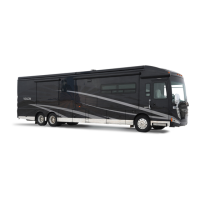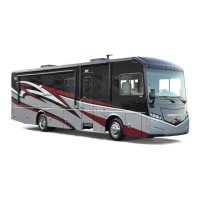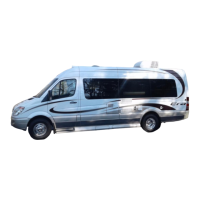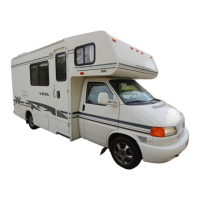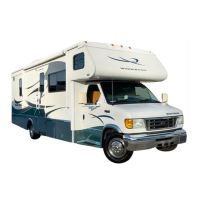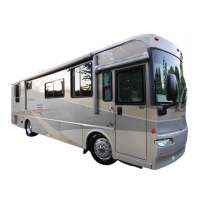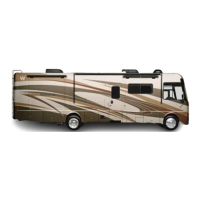Do you have a question about the Winnebago Trend and is the answer not in the manual?
Explains danger, warning, caution, and notice symbols used throughout the manual.
Explains the data on the vehicle certification label for identification and reference.
Key safety precautions for vehicle occupants and general operation.
Essential safety checks and practices before and during vehicle operation.
Safety guidelines and warnings related to fuel and propane gas systems.
Procedures to follow if propane gas leaks are detected, including safety steps.
Precautions and warnings regarding carbon monoxide hazards from engine exhaust.
Details the carbon monoxide alarm, its function, and replacement.
Information on the smoke alarm, its power source, and testing recommendations.
Location, inspection, and replacement guidelines for the fire extinguisher.
General safety precautions related to the vehicle's electrical system.
Guidelines for securely storing items to prevent dangerous projectiles during transit.
Instructions for using escape windows and slider windows as emergency exits.
Advice on handling roadside emergencies, particularly tire changes.
Instructions for jump starting the motorhome engine using the battery boost switch.
Procedure to follow if the engine overheats, including pulling over and stopping.
Instructions for proper use, fastening, adjustment, and care of seat belts.
Guidelines for installing and using child restraint systems securely in the vehicle.
How to use the battery boost switch for emergency engine starting.
Operation of the refrigerator using 120-Volt AC electric or propane gas.
Operation of the propane gas range top and safety precautions.
Operating instructions for the gas tankless water heater.
Procedure for starting up and shutting down the propane gas furnace.
Operation of the air conditioning unit with integrated heat strip for heating.
Overview of the propane gas system and its uses in the motorhome.
Adherence to industry requirements for safe operation of mobile propane gas equipment.
General warnings and precautions for using the propane gas system safely.
Step-by-step procedure to follow if propane gas leaks are detected.
Information on the regulator's protection, installation, and maintenance.
Essential safety precautions for handling electrical components and avoiding hazards.
Description of the 120-volt AC system, powered by shoreline or generator.
Location and function of the power converter and its panel components.
How circuit breakers protect the 120-volt system and how to reset them.
Function of GFCI outlets for shock protection and how to reset them.
Basic operation instructions for the 120-volt generator.
Description of the 12-volt DC system, including chassis and house batteries.
How to use the battery disconnect switch to prevent battery drain during storage.
Recommendations for maintaining battery health and preventing sulfating and freezing.
Provides water to various fixtures, supplied by tank or city water.
Operation of the demand pump for supplying water from the fresh water tank.
Procedure for disinfecting the potable water system using a chlorine solution.
Description of the self-contained waste water system with black and gray tanks.
Methods for winterizing the water and plumbing system using air or antifreeze.
Safety warning regarding walking or working on the vehicle roof.
Guidelines for distributing cargo weight to avoid exceeding vehicle weight ratings.
How to weigh the fully loaded coach to check weight distribution.
Information on hitch capacity, tongue weight, and towing considerations.
Definitions of weight ratings (GVWR, GAWR, GCWR) and their importance in towing.
Explains danger, warning, caution, and notice symbols used throughout the manual.
Explains the data on the vehicle certification label for identification and reference.
Key safety precautions for vehicle occupants and general operation.
Essential safety checks and practices before and during vehicle operation.
Safety guidelines and warnings related to fuel and propane gas systems.
Procedures to follow if propane gas leaks are detected, including safety steps.
Precautions and warnings regarding carbon monoxide hazards from engine exhaust.
Details the carbon monoxide alarm, its function, and replacement.
Information on the smoke alarm, its power source, and testing recommendations.
Location, inspection, and replacement guidelines for the fire extinguisher.
General safety precautions related to the vehicle's electrical system.
Guidelines for securely storing items to prevent dangerous projectiles during transit.
Instructions for using escape windows and slider windows as emergency exits.
Advice on handling roadside emergencies, particularly tire changes.
Instructions for jump starting the motorhome engine using the battery boost switch.
Procedure to follow if the engine overheats, including pulling over and stopping.
Instructions for proper use, fastening, adjustment, and care of seat belts.
Guidelines for installing and using child restraint systems securely in the vehicle.
How to use the battery boost switch for emergency engine starting.
Operation of the refrigerator using 120-Volt AC electric or propane gas.
Operation of the propane gas range top and safety precautions.
Operating instructions for the gas tankless water heater.
Procedure for starting up and shutting down the propane gas furnace.
Operation of the air conditioning unit with integrated heat strip for heating.
Overview of the propane gas system and its uses in the motorhome.
Adherence to industry requirements for safe operation of mobile propane gas equipment.
General warnings and precautions for using the propane gas system safely.
Step-by-step procedure to follow if propane gas leaks are detected.
Information on the regulator's protection, installation, and maintenance.
Essential safety precautions for handling electrical components and avoiding hazards.
Description of the 120-volt AC system, powered by shoreline or generator.
Location and function of the power converter and its panel components.
How circuit breakers protect the 120-volt system and how to reset them.
Function of GFCI outlets for shock protection and how to reset them.
Basic operation instructions for the 120-volt generator.
Description of the 12-volt DC system, including chassis and house batteries.
How to use the battery disconnect switch to prevent battery drain during storage.
Recommendations for maintaining battery health and preventing sulfating and freezing.
Provides water to various fixtures, supplied by tank or city water.
Operation of the demand pump for supplying water from the fresh water tank.
Procedure for disinfecting the potable water system using a chlorine solution.
Description of the self-contained waste water system with black and gray tanks.
Methods for winterizing the water and plumbing system using air or antifreeze.
Safety warning regarding walking or working on the vehicle roof.
Guidelines for distributing cargo weight to avoid exceeding vehicle weight ratings.
How to weigh the fully loaded coach to check weight distribution.
Information on hitch capacity, tongue weight, and towing considerations.
Definitions of weight ratings (GVWR, GAWR, GCWR) and their importance in towing.
| Category | Motorhomes |
|---|---|
| Class | Class C |
| Chassis | Ram ProMaster |
| Engine | 3.6L V6 |
| Fuel Type | Gasoline |
| GVWR | 9, 350 lbs |
| Sleeping Capacity | 4 |



